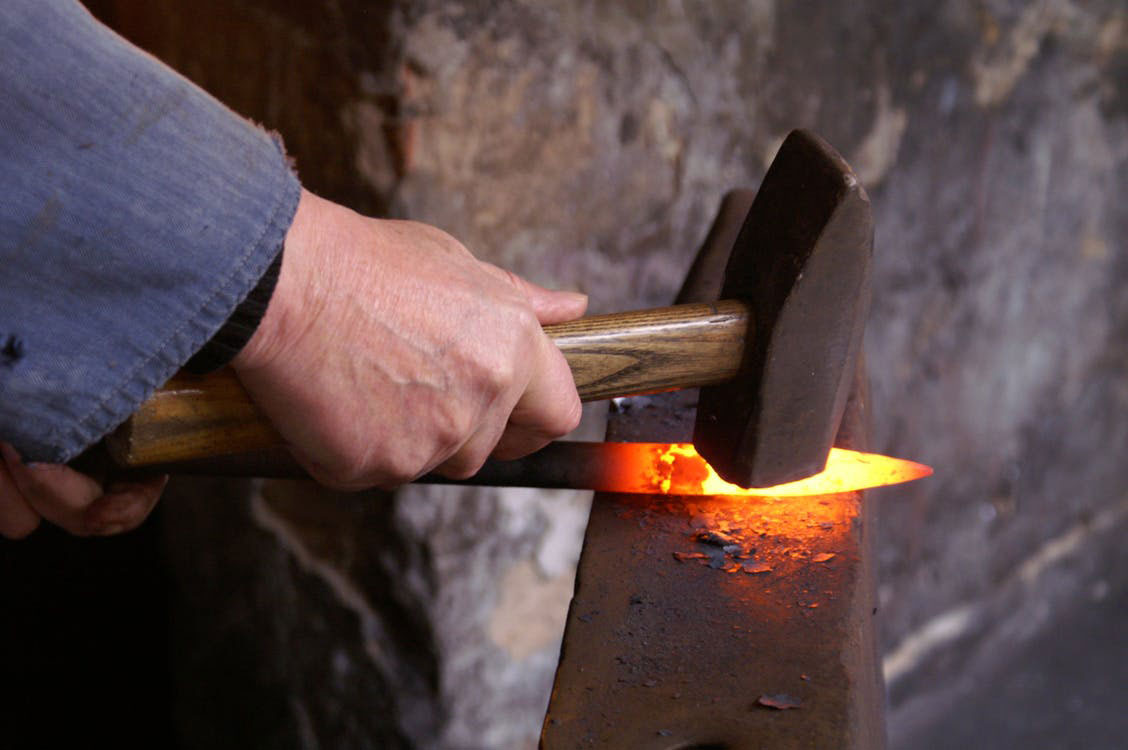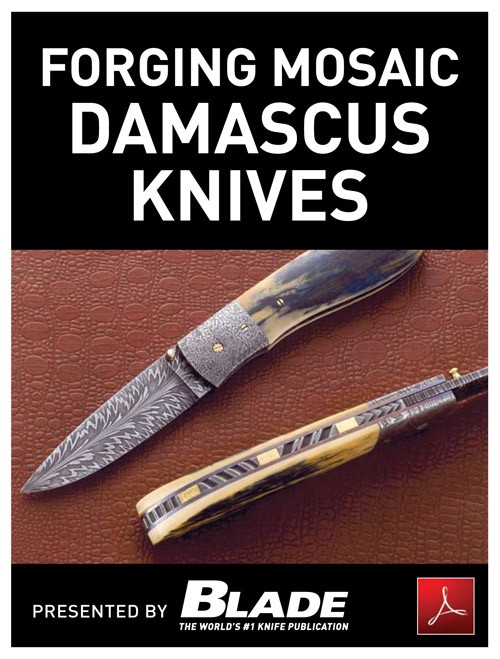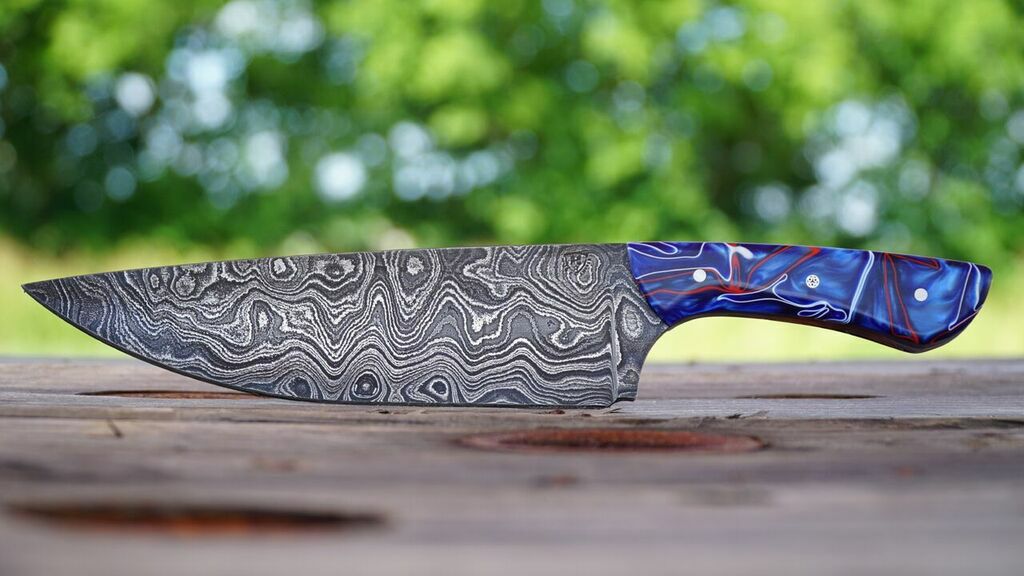![Best Rescue Knives [Field Tested] Best Rescue Knives [Field Tested]](https://blademag.com/wp-content/uploads/Rescue-Knife-9-768x512.jpg)
What better knife to carry daily than one explicitly designed to save lives?
Why rescue knives as EDC? It’s more like “why not?” Life presents situations you don’t expect—an accident happens and there you are, right in the middle of it. It is therefore very important to be and stay prepared. Having a rescue knife within close reach can help when you need it most.
But who really carries a rescue knife daily? If you are a fireman, EMT or in law enforcement, it’s an easy answer. Remember the be and stay prepared motto. Even if not in a save-and-serve profession, you can have a rescue knife with you for times you need it most.
Victorinox Rescue Tool
It probably is no surprise that Victorinox makes a rescue knife. The company is well known for fashioning super handy pocketknives with all sorts of onboard tools that make work, play and life easier and more convenient—and in this case, safer, too.
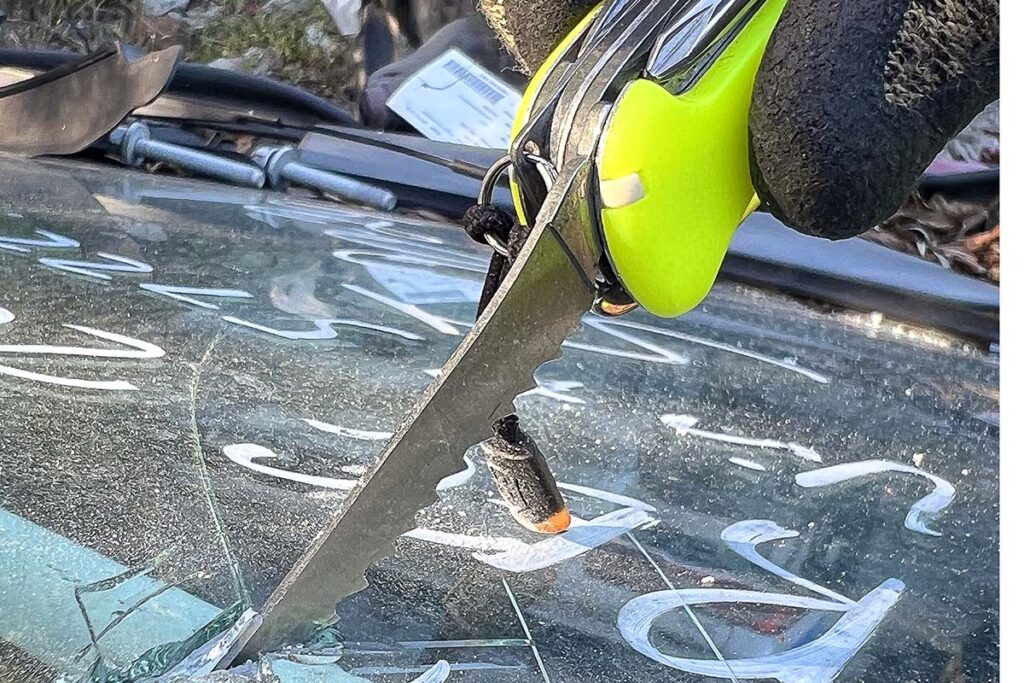
At about 4.4 inches closed, the Victorinox Rescue Tool has a frame based on the largest knife the company makes. This is definitely not a pocketknife! It comes with a high quality sewn and riveted nylon sheath (more on it later).
As with most Swiss Army knives, the Rescue Tool sports a variety of on-board tools: a partially serrated 3⅛-inch main blade with hole opener; bottle opener; flathead and Phillips screwdrivers; a combination can opener and small flathead screwdriver; a 3.25-inch semi-curved, fully serrated blade for cutting seatbelts; a specially designed 3.25-inch pull saw for cutting shatterproof glass; and a glass breaker. The latter two are removable. The polyamide scales come in high-visibility yellow for easy location in low light conditions, and the scales glow in the dark after being charged up by sunlight or artificial light. Fit and finish on the Rescue Tool is standard for Victorinox—perfect out of the box. The blades and tools are finished nicely in a full polish except for the saw blade, which is satin finished. Opening and closing action is smooth. The main partially serrated blade locks open via a linerlock as well.
The seatbelt cutter is extremely effective. The rounded, dull blade tip extends slightly beyond the handle butt so you can deploy the blade with or without gloves. Work the blade under the seatbelt and, with one swift motion, pull and the blade slices clean through. The serration pattern is similar to one you might see on a steak knife, with evenly spaced teeth—simple yet very effective and extremely sharp out of the box.
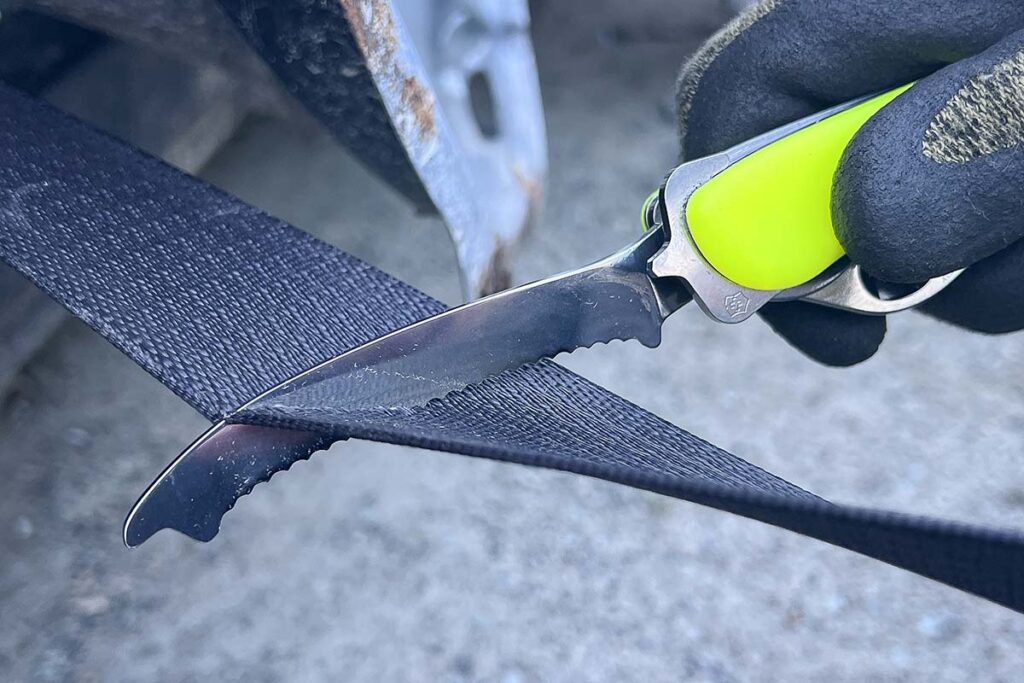
The partially serrated main blade is easy to deploy via the hole opener. The blade is unlike most if not all other partially serrated non-Victorinox patterns. The front 70 percent of the edge is serrated and the balance closest to the tang is plain for finer cutting. The serrations are more rounded at the tips than on the seatbelt cutter, presumably to allow the blade to cut evenly like a plain edge. I tested it on food, cardboard and manila rope, and it cut smoothly and aggressively.
Now for the disappointing part—the glass breaker. It was not effective at all. I could not get a side car window to shatter no matter how hard I hit it. I presume the failure is due to the breaker point being too big. In my experience, the most effective glass breakers are the ones that come to a point and are made of carbide, as with the balance of the review knives. The glass saw is effective, though it grabs a bit too much on the pull stroke. However, when I adjusted the pressure it worked. Country of origin: Switzerland. MSRP: $115.
SOG Escape 2.0 ATK
The SOG Escape 2.0 ATK is the updated version of the original SOG Escape, a multipurpose rescue folder targeted at the serve and save pros. It features a 3.4-inch blade of AUS-8 stainless steel PVD coated black, a partially serrated edge, anodized aluminum handle, integrated/replaceable seatbelt/line cutter, and glass breaker. The blade sports ambidextrous thumb studs and a flipper for one-hand opening. The edge is serrated to tackle a plethora of cutting chores. The clip point shape is adaptable to a wide range of tasks and the defined point is great for scoring. The serrations provide extra slicing power when the going gets tough.
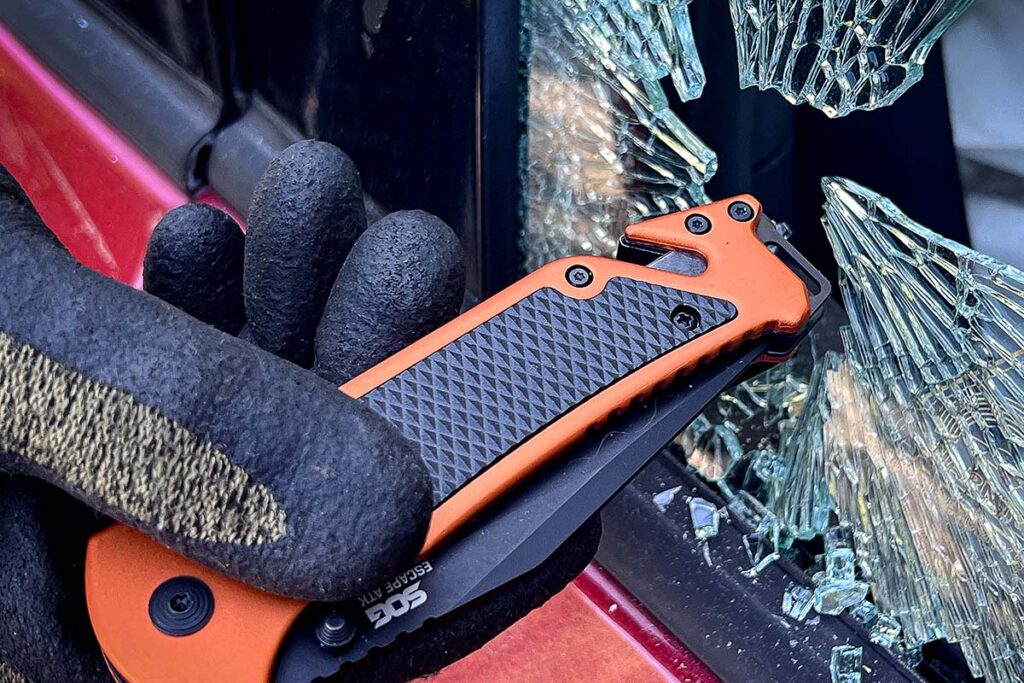
The handle is cast aluminum with stainless steel liners. It comes in two colors: high visibility orange and OD green. The integrated slot at the butt houses a blade for cutting seatbelts, line and string without opening the knife. A glass breaker in the handle spacer quickly shatters side car windows. The breaker works very well. It quickly shattered the side glass with a concentrated pop to the lower corner of the window. The pocket clip is a fold-over, deep carry model. A spare seatbelt/line cutter blade stows safely beneath the textured panel handle inlay. Back out the two small Phillips screws securing the cover and you will see the blade underneath—it is simple to swap out. Country of origin: China. MSRP: $54.95.
Kershaw Drivetrain
Kershaw’s Drivetrain rescue knife looks like any standard EDC linerlock folder. It has a stylish handle coupled with a very utility friendly blade—but that’s where the similarity ends. The presentation side of the handle butt boasts an integrated seatbelt cutter that folds out. A glass breaker is inserted into the end of the handle spacer. The 3.2-inch clip point blade has ambidextrous thumb studs and a flipper for one-hand opening enhanced by the company’s SpeedSafe assist mechanism. The blade is D2 tool steel for augmented edge holding and wear resistance, especially for the price point. The stonewash finish is attractive and hides scratches.
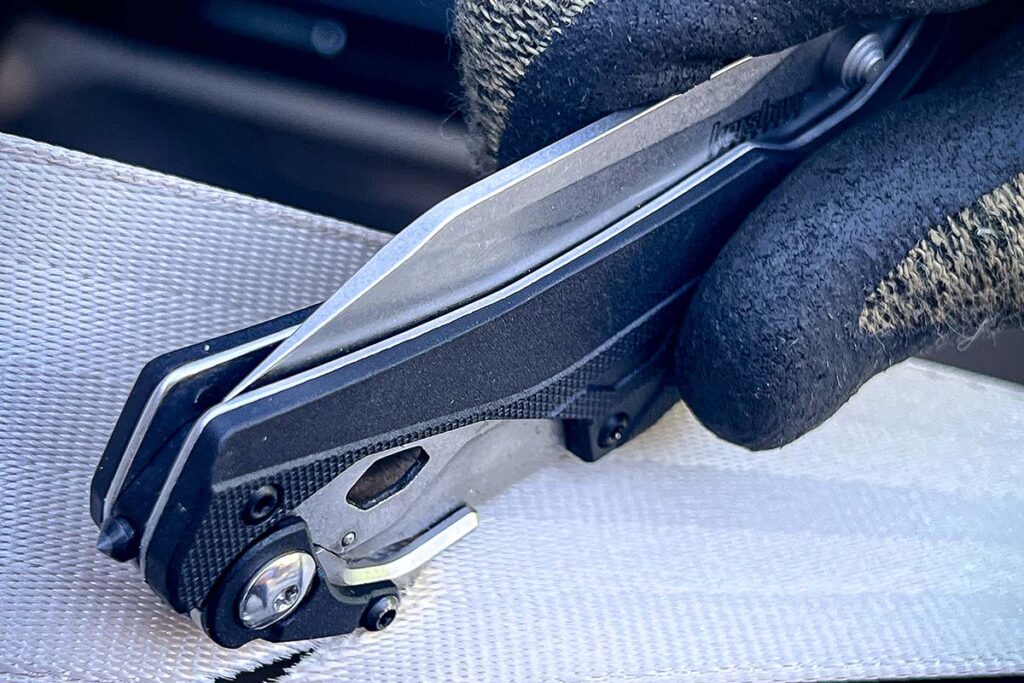
The handle is molded glass reinforced nylon with double stainless steel liners. The scales are textured and contoured for a nonslip, comfortable grip with no hot spots. The seatbelt cutter easily deploys with one hand and a separate linerlock holds it in place. When closed, the cutter is concealed within the lines of the handle profile and doesn’t get in the way. A steel pocket clip carries the closed knife blade tip up.
The blade is very utility friendly, from opening boxes and mail to cutting cardboard and plastic sheeting. Once locked open, it is extremely secure with no play.
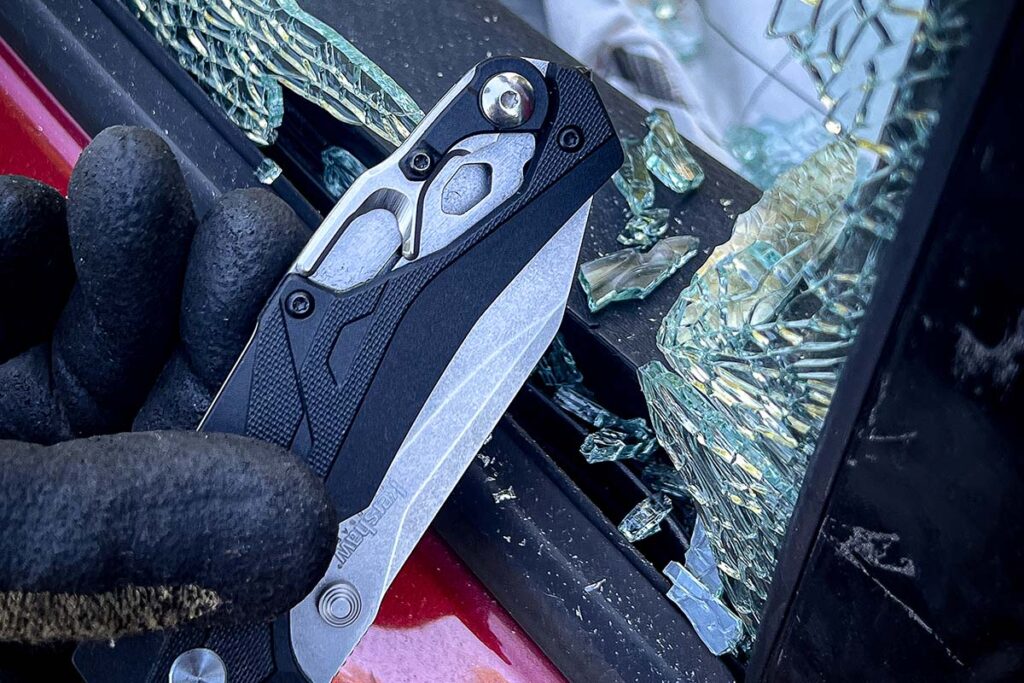
The seatbelt cutter works well. The hook tip is dull and rounded so you can work it under the seatbelt without inadvertently cutting yourself or the accident victim. The blade is ground on both sides to enhance sharpness. For best results, make your pull cut at an angle in relation to the seatbelt. Also, resting the handle spine on the seatbelt is a great way to “aim” the cutter. It bites in better that way and, when you feel it engage, give the handle a quick tug and it cleaves through effortlessly. It is a surprisingly effective seatbelt cutter! The glass breaker works very well, too. Country of origin: U.S. design, prototype and quality control, Chinese manufacture. MSRP: $69.59.
Utica’s Honor Rescue Knife
Utica’s Honor Rescue Knife is the least expensive of the test group. It packs a few features normally found on rescue knives, such as the integrated seatbelt cutter, glass breaker and a partially serrated, modified tanto blade. The 3-inch stainless steel blade’s partial serrations help rip through thicker materials. A two-tone finish adds character, with the bevels and spine black oxide coated and the flats satin finished. A flipper tab provides ambidextrous opening, and the blade rides effortlessly on bearings for ultra smooth action. The handle is aluminum with double stainless steel liners providing the backbone. A linerlock holds the blade open securely. A seatbelt cutter slot in the handle butt has two sharpened blades held in the scissor position to cleave seatbelts with a firm pull. The steel back spacer has an extended portion that tapers to a point, which serves as the glass breaker.
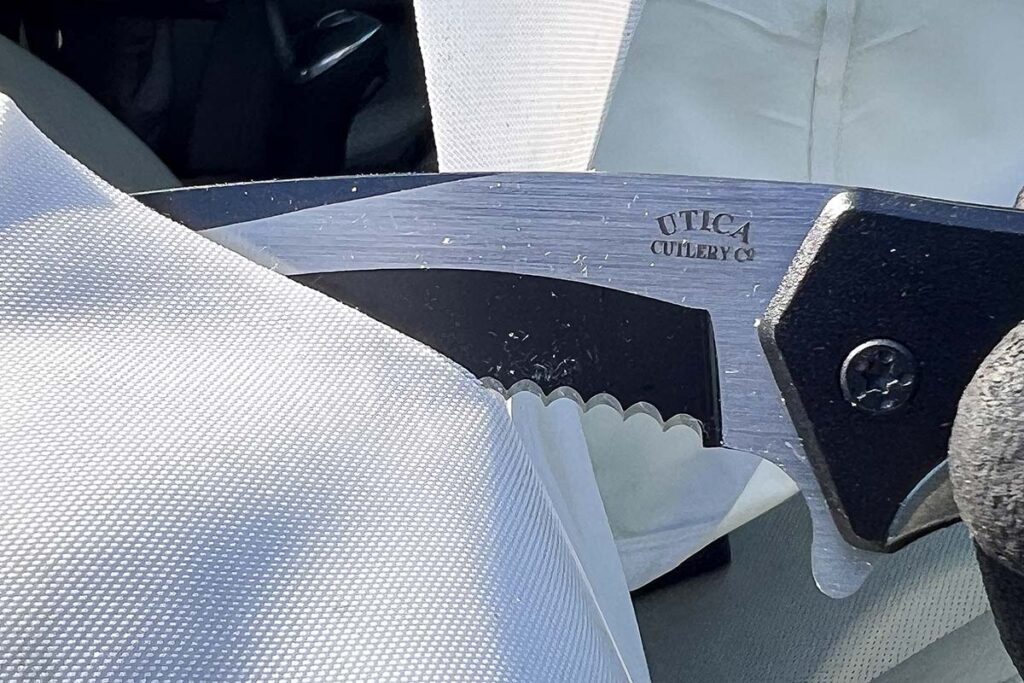
Like with the Victorinox Rescue Tool, the glass breaker on the Utica test model was ineffective. The point rounded off due to multiple hits to a side window and did not shatter it. The breaker needs a carbide point. A deep carry clip positions the closed knife blade tip down. Cost and feature wise, the Honor Rescue Knife is a great option without breaking the bank. Country of origin: China. MSRP: $32.97.
Final Cut
A final thought: Some prefer having a rescue knife for emergencies only as opposed to having one for both work and emergencies. You can get away with a relatively inexpensive rescue knife if you preserve it for emergency use exclusively. (Some high-end rescue knives cost as much as regular tactical folders, that is, several hundred dollars.) There’s nothing wrong with an inexpensive rescue knife as long as the manufacturing quality is there, the blade lock holds and the blade is sharp. If you are adept at doing so, sharpen the blade first before stowing it away; this way you know the blade is very sharp. And since you won’t be using it as an EDC, the sharp edge will be preserved. This works well if you have multiple vehicles in your family that you wish to outfit with rescue knives.
Where To Keep Your Rescue Knife
Keeping a rescue knife in your vehicle is a great idea as it can help free you and others should you have an accident or happen upon one. However, give careful thought to where you stow the knife.
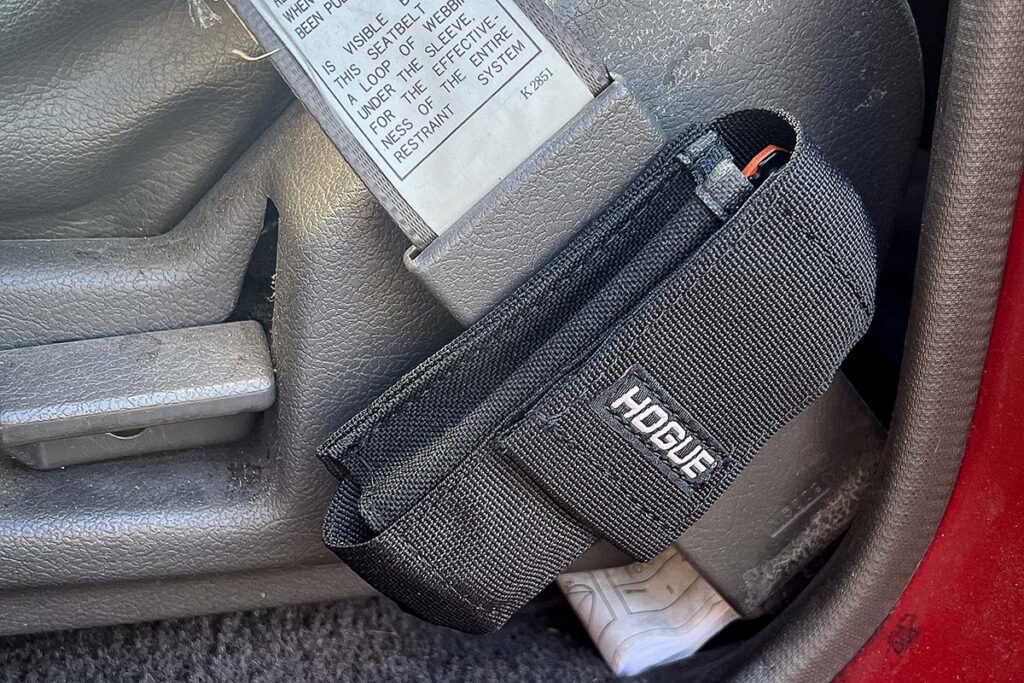
Most assume a glovebox is a safe place and while not a wrong choice, it is a poor one. Why? For one, in an accident your seatbelt may not release because of the tension; in essence, you’re strapped to the driver’s seat and cannot lean over to access the glovebox. Worse, the vehicle could be upside down or on its side. In other words, have the knife placed securely within arm’s length.
I keep a Benchmade Auto Triage inside the sunglass holder in the roof of my car, just above the inside rearview mirror. It is secured shut with a latch so it won’t pop open on impact. I can easily reach it and remove it from the holder with my right hand. In my truck I keep a Hogue Trauma rescue folder in the sheath wrapped around the lower portion of the seatbelt anchor in between the seat and the door. It’s just enough room for me to access the knife with the door shut, and the knife is secured in that position and won’t move.
The worst place to keep the knife is in the center console cupholder. While it’s convenient to access, if you get rear ended or t-boned, the knife will go airborne and land way out of reach. Some vehicles may have a center console storage/armrest in the middle. Yeah, mine in each vehicle is a clutter catchall for receipts and other junk, but it’s another ideal location because the armrest lid latches shut and is within arm’s reach.
Read More Knife Reviews:
- Best Rescue Tools
- Oknife Beagle Review
- Versa Rescue Knife Review
- Knife Review: CRKT Bamboozled
- M-1 Folder Review: How Good Is This Folder?
 NEXT STEP: Download Your Free KNIFE GUIDE Issue of BLADE Magazine
NEXT STEP: Download Your Free KNIFE GUIDE Issue of BLADE Magazine
BLADE’s annual Knife Guide Issue features the newest knives and sharpeners, plus knife and axe reviews, knife sheaths, kit knives and a Knife Industry Directory.Get your FREE digital PDF instant download of the annual Knife Guide. No, really! We will email it to you right now when you subscribe to the BLADE email newsletter.


